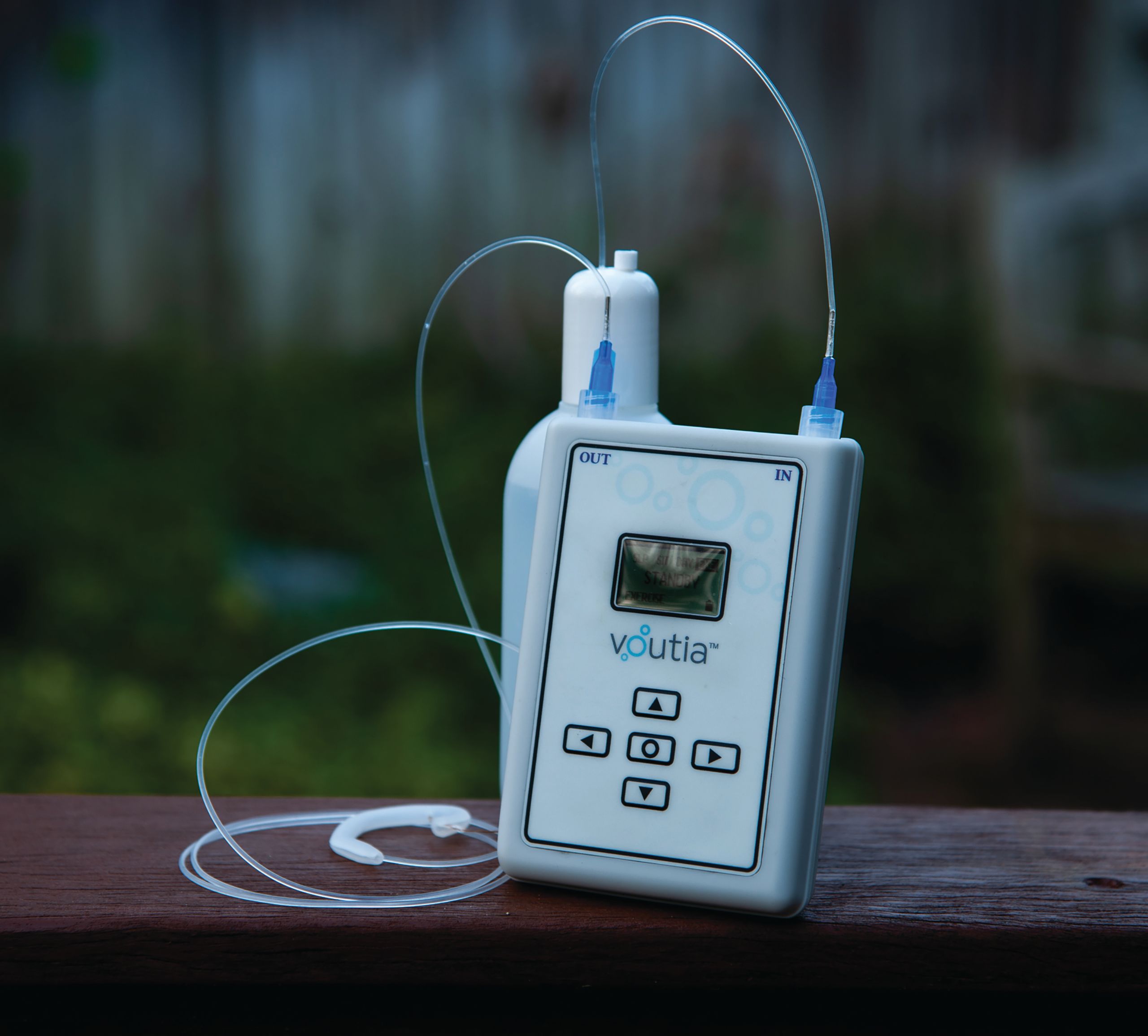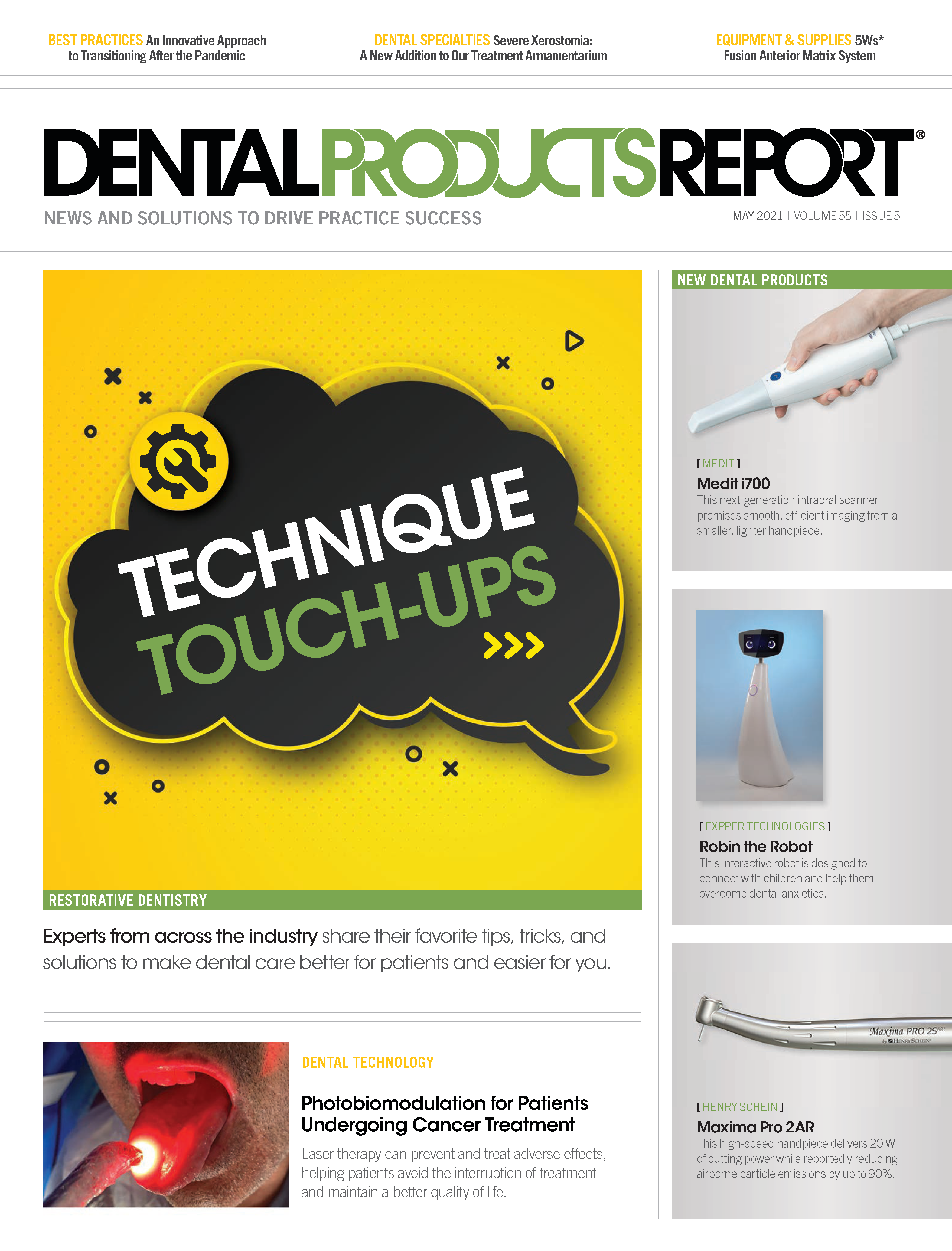Severe Xerostomia: A New Addition to Our Treatment Armamentarium
Voutia is a pump-based device that is designed to address xerostomia by mimicking natural saliva.

In the US alone, an estimated 17 million people with xerostomia experience symptoms severe enough to impair their daily quality of life.1-3 As dentists, we treat patients seeking relief from the perpetual discomfort of desiccated tissues caused by lack of saliva. We see the ravages to the oral cavity’s soft and hard tissues when moisture is depleted, and we share our patient’s frustration when we are unable to provide an adequate solution.
Thomas Eschenroeder, DDS

Etiologies of xerostomia include radiation, chemotherapy, autoimmune illness, polypharmacy, and the aging process. Although care for the underlying illness is provided by a range of medical specialists, dealing with the associated xerostomia most often falls to dental professionals. However, our armamentarium of treatments for the most severe, unremitting cases is only marginally effective. Limited by the nature of their approach to the problem, remedies including mouthwashes, lozenges, dietary changes, and prescription medications often fail to provide satisfying, long-term results.
They fail because they do not replace what is missing: moisture.
In the medical arena, innovative devices to replace the function of missing, damaged, or diseased organs and tissues have been available for decades. Cardiology has the left ventricular assist device, or LVAD; ear, nose and throat specialists have cochlear implants; and endocrinologists have the insulin pump.
Taking a cue from these technologies, Voutia™ (Vō-teé-ә)—a novel pump-based device that addresses the long-term problem with a solution that mimics natural salivary function—became available to dentists and their patients in February.
Concept and Development
Finding a practical answer for xerostomia sufferers has been a very long and personal mission for Jeffrey Cash, DDS, founder and chief science officer of Virginia Head and Neck Therapeutics, Inc, and inventor of Voutia. His dental school training was followed by a 2-year residency working with patients with head and neck cancers at a Department of Veterans Affairs hospital. At the time, Dr Cash felt powerless when confronted with patients who were having trouble swallowing, sleeping, and talking as a result of salivary gland damage caused by chemotherapy and radiation, he says.
Little did he realize that less than 1 year out of residency, he would undergo his own cancer treatment and experience firsthand the misery of severe xerostomia. Those early events led Dr Cash to begin considering the notion of directly replacing salivary moisture as a potential treatment.
He thought about it for nearly 2 decades, with work on the device taking a back seat to raising a family and practicing dentistry. In the past 5 years, Dr Cash recommitted to the work and became intent on making preliminary ideas and sketches come to life.
Failures with initial gravity-fed concepts quickly demonstrated the need to precisely control moisture flow. However, off-the-shelf pumps did not offer the desired combination of flow regulation, footprint, and cost, and developing custom circuit boards and the computer code to regulate flow consistently with salivary function proved a significant challenge, Dr Cash says.
The initial prototypes were heavy and bulky. Today, the pump unit is only slightly larger than a smartphone and weighs just a few ounces.
How Voutia Works
Voutia mimics natural salivary function by providing a slow and measured flow of water to the oral cavity. The device is a patented, US Food and Drug Administration–cleared system that incorporates a quiet, lightweight micropump, a water bottle, and ultrafine tubing to deliver a continuous moisture stream directly to the wearer’s mouth. The device is fully portable and can be used 24 hours per day, 7 days per week—even during sleep. The small earpiece and microtube make Voutia nearly imperceptible during normal social interaction.
The pump pushes water through tubing concealed under the user’s clothing up to the small silicone earpiece. From the earpiece, water passes through a tiny microtube that rests comfortably between the teeth and the buccal mucosa. The microtube, which is approximately the diameter of a strand of hair, is practically invisible from 4 to 6 feet away. The pump is calibrated to deliver water at a rate matching the normal physiologic range of basal salivary secretion.4 The system has several preset flow rates that allow the user to adjust rates to match their activity and lifestyle. It is important to note that the earpiece and tubing are compatible with most hearing aids, nasal oxygen cannulas, and continuous positive air pressure, or CPAP machines.
The Results
For more than 4 years, the Voutia system has been successfully beta tested by volunteers with severe dry mouth symptoms. For these patients, traditional treatments offered transitory relief at best and, in some cases, no benefit at all. Feedback from the beta test population, and subsequent early adopters, has been overwhelmingly positive. Among the results, users have reported a more normal feel to their oral cavity, reduced general discomfort, fewer sleep disruptions, restoration of a more normal speaking voice, and a decreased need for OTC pain medications, according to the beta test results compiled by Voutia.
It can be hard to fully appreciate just how impactful having an effective therapy is to the daily lives of severe xerostomia sufferers. Jane Middleton, a retired educator and researcher, has been among the initial beta testers.
Her severe dry mouth resulting from Sjögren syndrome had a range of symptoms, with difficulty sleeping being among the most debilitating, she says. An important feature of Voutia is the ability for patients to use it at night, when dry mouth is often at its worst. Not only was Middleton able to sleep more comfortably without disruption but, after waking in the morning, she experienced lingering moisture for several hours without assistance of the device, she explains.
In addition, she lived with the frustration and isolation of not being able to speak clearly enough to be understood. On this issue, Middleton says, “The device allows me to be a part of the world I live in and interact with others. I never want to be without it.”
No Limitations
This system is designed for different lifestyles, and it can be carried in a shoulder bag, attached to a belt, or secured in a waist pack. One active wearer who enjoys gardening places his unit in a pouch, which allows him to pursue his hobby unencumbered. The system is also compatible with exercise routines such as yoga, walking, and bike riding.
The water bottle has a hydrophobic foam seal to equalize pressure as the fluid is depleted and can, therefore, function at any angle without spillage. For more vigorous activities, the tubing can be easily secured with dermal tape. It should be noted that the system is not designed to be a replacement for daily hydration. The range of scientifically reported basal salivary secretion—normal saliva flow—is 0.1 ml/min to 0.9 ml/min.4 Active sports participants still need to use alternate hydration methods in addition to Voutia.
Access to Voutia
The Voutia system is currently available at voutia.com. Patients who wish to purchase this device directly can use funding from their health savings accounts or flexible spending accounts. On a case-by-case basis, medical insurance may provide coverage when supported with a clinician’s letter of medical necessity. Professional pricing is also provided for dentists who wish to integrate Voutia into their xerostomia treatment protocols. For more information, visit voutia.com/healthcare-professionals.
References
- Plemons JM, Al-Hashimi I, Marek CL; American Dental Association Council on Scientific Affairs. Managing xerostomia and salivary gland hypofunction: executive summary of a report from the American Dental Association Council on Scientific Affairs. J Am Dent Assoc. 2014;145(8):867-873. doi:10.14219/jada.2014.44
- Turner MD, Ship JA. Dry mouth and its effects on the oral health of elderly people. J Am Dent Assoc. 2007;138(suppl 1):S15-S20. doi:10.14219/jada.archive.2007.0358
- Braam PM, Roesink JM, Raaijmakers CP, Busschers WB, Terhaard CH. Quality of life and salivary output in patients with head-and-neck cancer five years after radiotherapy. Radiat Oncol. 2007;2:3. doi:10.1186/1748-717X-2-3
- Iorgulescu G. Saliva between normal and pathological. Important factors in determining systemic and oral health. J Med Life. 2009;2(3):303-307.

ACTIVA BioACTIVE Bulk Flow Marks Pulpdent’s First Major Product Release in 4 Years
December 12th 2024Next-generation bulk-fill dental restorative raises the standard of care for bulk-fill procedures by providing natural remineralization support, while also overcoming current bulk-fill limitations.